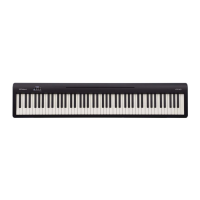31
Other Important Function
5. Use the [–] [+] buttons to select the type of musette
detune.
Parameter Value
MusetTyp
(Musette Detune Type)
Off (no detune), Dry, Classic, F-Folk,
American_L, American_H, North_Europe,
German_L, D Folk_L, Italian_L, German_H,
Alpine, Italian_H, D-Folk_H, French, Scottish
6. Press the [EXIT/NO] button several times to return to
the main screen.
To save this change, refer to “How to Save a Set” (p. 33).
Scale (Tuning)
Almost every music culture has its own accordion variety.
Arabic, Indonesian and other musical cultures do not use the equal
temperament that is favored in Europe, the Americas, etc.
The FR-4x features a “Scale” parameter that allows you to select
the tuning system that best fits the music you want to play.
If the tuning system you need is not among the factory settings,
you can program it yourself, save it to a User 1~3 memory and then
select it here.
&
“Scale Tune Edit” (p. 76)
1. In the main screen, press the [MENU] button.
2. Use the [
K
] [
J
] buttons to select “System.”
3. Press the [ENTER/YES] button.
4. Use the [
K
] [
J
] buttons to select “Tuning.”
5. Press the [ENTER/YES] button.
6. Use the [
K
] [
J
] buttons to select “S. TunTyp.”
The display changes to:
7. Use the [–] [+] buttons to select the type of scale.
Type Display Explanation
Equal
(Off) This tuning divides each
octave into 12 equal steps
(intervals).
User 1–3
These settings refer to the
tuning systems programmed
by yourself (or someone else).
&
“Scale Tune Edit” (p. 76)
Arabic 1,
Arabic 2
These two settings refer to
Arabic tuning systems.
5 Select “1” to lower the E and
B notes by a quarter tone
(–50 cents).
5 “2” represents a scale where
the E and A are tuned down a
quarter tone.
Just Major
This is a classical (western)
tuning that resolved the
ambiguity of fifths and thirds.
Quite beautiful sonorities are
produced with chords, but the
scale is unbalanced, so it is not
well-suited for melodies.
Type Display Explanation
Just Minor
This is a just scale for pieces in
minor keys.
Pythagorean
This system was invented in
ancient Greece. It resolves the
ambiguity of fourths and fifths.
Though thirds are somewhat
imperfect, melodies sound
clearer.
Mean Tone
A temperament that adds
some compromises to the just
temperament and facilitates
transposition.
Werckmeister
A combination of the Mean
Tone and Pythagorean
temperaments, this tuning
allows for playing in any key.
Kirnberger
As a result of improvements
made to the Mean Tone and
Just temperaments, this tuning
system is relatively tolerant
towards transposition and can
be used to play in all keys.
8. Use the [
K
] [
J
] buttons to select “S. TunPat.”
9. Use the [–] [+] buttons to select the part whose scale
you want to specify.
ASSIGNED PART Display Explanation
Accordion
Accordion part
Orchestra
Orchestra part
Accordion &
Orchestra
Accordion part and Orchestra
part
Bass&Chord
Bass & Chord part
Orch Bass
Orchestra Bass part
Orch Chord
Orchestra Chord part
Orch Free Bass
Orchestra Free Bass part
ALL
Select “All” to assign your
settings to all parts.
MEMO
Except for “Equal,” you also need to specify the root /
fundamental (“C” for major and “A” for minor) according to
the key of the song to be played.
10. Use the [
K
] [
J
] buttons to select “S. TunKey.”
11. Use the [–] [+] buttons to select the root of the
scale in the range of C–B.
12. Press the [EXIT/NO] button several times to return
to the main screen.
To save this change, refer to “How to Save System Parameters”
(p. 86).

